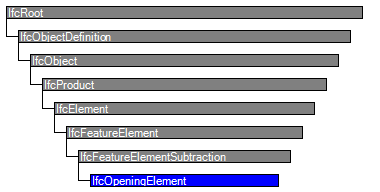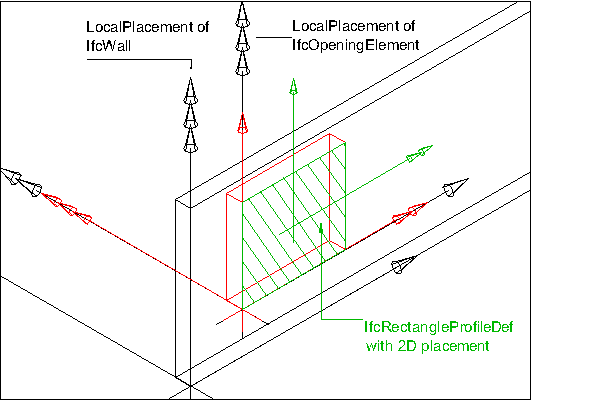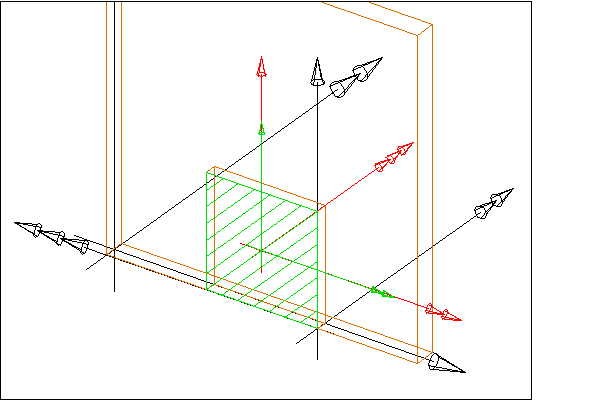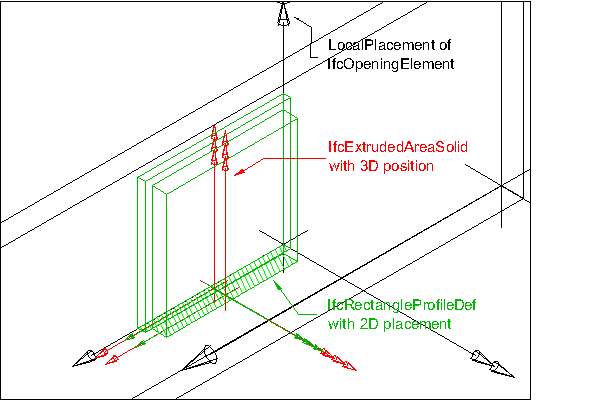Natural language names
 | Öffnung |
 | Opening Element |
 | Ouverture |
Change log
| Item | SPF | XML | Change | Description | IFC2x3 to IFC4 4.0.0.0 |
|---|---|---|---|---|
| IfcOpeningElement | ||||
| OwnerHistory | MODIFIED | Instantiation changed to OPTIONAL. | ||
| PredefinedType | ADDED | IFC4 Addendum 1 4.0.1.0 | ||
| IfcOpeningElement | ||||
| HasCoverings | ADDED | IFC4x2 Candidate 4.2.0.0 | ||
| IfcOpeningElement | ||||
| PositionedRelativeTo | ADDED | IFC4x3_RC3 to IFC4x3_RC4 | ||
| IfcOpeningElement | ||||
| HasSurfaceFeatures | ADDED |
Semantic definitions at the entity
Entity definition
The opening element stands for opening, recess or chase, all reflecting voids. It represents a void within any element that has physical manifestation. Openings can be inserted into walls, slabs, beams, columns, or other elements.
The IFC specification provides two entities for opening elements:
- IfcOpeningStandardCase is used for all openings that have a constant profile along a linear extrusion. They are placed relative to the voided elements and the extrusion direction is perpendicular to the plane of the element (horizontally for walls, vertically for slabs). Only a single extrusion body is allowed. It cuts through the whole thickness of the voided element, i.e. it reflects a true opening.
- IfcOpeningElement is used for all other occurrences of openings and in particular also for niches or recesses.
NOTE View definitions or implementer agreements may restrict the types of elements which can be voided by an IfcOpeningElement or IfcOpeningStandardCase
There are two different types of opening elements:
- an opening, where the thickness of the opening is greater or equal to the thickness of the element;
- a recess or niche, where the thickness of the recess is smaller than the thickness of the element.
The attribute PredefinedType should be used to capture the differences,
- the attribute is set to OPENING for an opening or
- the attribute is set to RECESS for a recess or niche.
- If the value for PredefinedType is omitted, or the value is set to NOTDEFINED, no specific information of whether it is an opening or recess shall be assumed.
An IfcOpeningElement has to be inserted into an IfcElement by using the IfcRelVoidsElement relationship. It may be filled by an IfcDoor, IfcWindow, or another filling element by using the relationship IfcRelFillsElements. Depending on the type of the IfcShapeRepresentation of the IfcOpeningElement the voiding relationship implies:
- if the IfcShapeRepresentation.<emRepresentationIdentifier = 'Body', then the Body shape represntation of the opening has to be subtracted from the body shape representation of the voided element - implicit Boolean difference operation.
- if the IfcShapeRepresentation.<emRepresentationIdentifier = 'Reference', then the Reference shape representation of the opening is not subtracted, it is provided in addition to the hole in the Body shape representation of the voided element.
The IfcOpeningElement shall not participate in the containment relationship, i.e. it is not linked directly to the spatial structure of the project. It has a mandatory VoidsElements inverse relationship pointing to the IfcElement that is contained in the spatial structure.
- The inverse relationship ContainedInStructure shall be NIL.
NOTE See IfcRelVoidsElement for a diagram on how to apply spatial containment and the voiding relationship.
HISTORY New entity in IFC1.0
IFC2x CHANGE The intermediate ABSTRACT supertypes IfcFeatureElement and IfcFeatureSubtraction have been added.
IFC4 CHANGE The attribute PredefinedType has been added at the end of attribute list. It should be used instead of the inherited attribute ObjectType from now on.
Attribute definitions
| # | Attribute | Type | Cardinality | Description | G |
|---|---|---|---|---|---|
| 9 | PredefinedType | IfcOpeningElementTypeEnum | ? |
Predefined generic type for an opening that is specified in an enumeration. There may be a property set given specificly for the predefined types.
IFC4 CHANGE The attribute has been added at the end of the entity definition. | X |
| HasFillings | IfcRelFillsElement @RelatingOpeningElement | S[0:?] | Reference to the Filling Relationship that is used to assign Elements as Fillings for this Opening Element. The Opening Element can be filled with zero-to-many Elements. | X |
Formal Propositions
| Rule | Description |
|---|---|
| CorrectPredefinedType | Either PredefinedType is unset or the inherited attribute ObjectType shall be provided, if the PredefinedType is set to USERDEFINED or PredefinedType. |
Inherited definitions from supertypes
Entity inheritance

Attribute inheritance
| # | Attribute | Type | Cardinality | Description | G |
|---|---|---|---|---|---|
| IfcRoot | |||||
| 1 | GlobalId | IfcGloballyUniqueId | Assignment of a globally unique identifier within the entire software world. | X | |
| 2 | OwnerHistory | IfcOwnerHistory | ? |
Assignment of the information about the current ownership of that object, including owning actor, application, local identification and information captured about the recent changes of the object,
NOTE only the last modification in stored - either as addition, deletion or modification. IFC4 CHANGE The attribute has been changed to be OPTIONAL. | X |
| 3 | Name | IfcLabel | ? | Optional name for use by the participating software systems or users. For some subtypes of IfcRoot the insertion of the Name attribute may be required. This would be enforced by a where rule. | X |
| 4 | Description | IfcText | ? | Optional description, provided for exchanging informative comments. | X |
| IfcObjectDefinition | |||||
| HasAssignments | IfcRelAssigns @RelatedObjects | S[0:?] | Reference to the relationship objects, that assign (by an association relationship) other subtypes of IfcObject to this object instance. Examples are the association to products, processes, controls, resources or groups. | X | |
| Nests | IfcRelNests @RelatedObjects | S[0:1] | References to the decomposition relationship being a nesting. It determines that this object definition is a part within an ordered whole/part decomposition relationship. An object occurrence or type can only be part of a single decomposition (to allow hierarchical strutures only).
IFC4 CHANGE The inverse attribute datatype has been added and separated from Decomposes defined at IfcObjectDefinition. | X | |
| IsNestedBy | IfcRelNests @RelatingObject | S[0:?] | References to the decomposition relationship being a nesting. It determines that this object definition is the whole within an ordered whole/part decomposition relationship. An object or object type can be nested by several other objects (occurrences or types).
IFC4 CHANGE The inverse attribute datatype has been added and separated from IsDecomposedBy defined at IfcObjectDefinition. | X | |
| HasContext | IfcRelDeclares @RelatedDefinitions | S[0:1] | References to the context providing context information such as project unit or representation context. It should only be asserted for the uppermost non-spatial object.
IFC4 CHANGE The inverse attribute datatype has been added. | X | |
| IsDecomposedBy | IfcRelAggregates @RelatingObject | S[0:?] | References to the decomposition relationship being an aggregation. It determines that this object definition is whole within an unordered whole/part decomposition relationship. An object definitions can be aggregated by several other objects (occurrences or parts).
IFC4 CHANGE The inverse attribute datatype has been changed from the supertype IfcRelDecomposes to subtype IfcRelAggregates. | X | |
| Decomposes | IfcRelAggregates @RelatedObjects | S[0:1] | References to the decomposition relationship being an aggregation. It determines that this object definition is a part within an unordered whole/part decomposition relationship. An object definitions can only be part of a single decomposition (to allow hierarchical strutures only).
IFC4 CHANGE The inverse attribute datatype has been changed from the supertype IfcRelDecomposes to subtype IfcRelAggregates. | X | |
| HasAssociations | IfcRelAssociates @RelatedObjects | S[0:?] | Reference to the relationship objects, that associates external references or other resource definitions to the object.. Examples are the association to library, documentation or classification. | X | |
| IfcObject | |||||
| 5 | ObjectType | IfcLabel | ? | The type denotes a particular type that indicates the object further. The use has to be established at the level of instantiable subtypes. In particular it holds the user defined type, if the enumeration of the attribute PredefinedType is set to USERDEFINED. | X |
| IsDeclaredBy | IfcRelDefinesByObject @RelatedObjects | S[0:1] | Link to the relationship object pointing to the declaring object that provides the object definitions for this object occurrence. The declaring object has to be part of an object type decomposition. The associated IfcObject, or its subtypes, contains the specific information (as part of a type, or style, definition), that is common to all reflected instances of the declaring IfcObject, or its subtypes.
IFC4 CHANGE New inverse relationship, change made with upward compatibility for file based exchange. | X | |
| Declares | IfcRelDefinesByObject @RelatingObject | S[0:?] | Link to the relationship object pointing to the reflected object(s) that receives the object definitions. The reflected object has to be part of an object occurrence decomposition. The associated IfcObject, or its subtypes, provides the specific information (as part of a type, or style, definition), that is common to all reflected instances of the declaring IfcObject, or its subtypes.
IFC4 CHANGE New inverse relationship, change made with upward compatibility for file based exchange. | X | |
| IsTypedBy | IfcRelDefinesByType @RelatedObjects | S[0:1] | Set of relationships to the object type that provides the type definitions for this object occurrence. The then associated IfcTypeObject, or its subtypes, contains the specific information (or type, or style), that is common to all instances of IfcObject, or its subtypes, referring to the same type.
IFC4 CHANGE New inverse relationship, the link to IfcRelDefinesByType had previously be included in the inverse relationship IfcRelDefines. Change made with upward compatibility for file based exchange. | X | |
| IsDefinedBy | IfcRelDefinesByProperties @RelatedObjects | S[0:?] | Set of relationships to property set definitions attached to this object. Those statically or dynamically defined properties contain alphanumeric information content that further defines the object.
IFC4 CHANGE The data type has been changed from IfcRelDefines to IfcRelDefinesByProperties with upward compatibility for file based exchange. | X | |
| IfcProduct | |||||
| 6 | ObjectPlacement | IfcObjectPlacement | ? | Placement of the product in space, the placement can either be absolute (relative to the world coordinate system), relative (relative to the object placement of another product), or constraint (e.g. relative to grid axes). It is determined by the various subtypes of IfcObjectPlacement, which includes the axis placement information to determine the transformation for the object coordinate system. | X |
| 7 | Representation | IfcProductRepresentation | ? | Reference to the representations of the product, being either a representation (IfcProductRepresentation) or as a special case a shape representations (IfcProductDefinitionShape). The product definition shape provides for multiple geometric representations of the shape property of the object within the same object coordinate system, defined by the object placement. | X |
| ReferencedBy | IfcRelAssignsToProduct @RelatingProduct | S[0:?] | Reference to the IfcRelAssignsToProduct relationship, by which other products, processes, controls, resources or actors (as subtypes of IfcObjectDefinition) can be related to this product. | X | |
| PositionedRelativeTo | IfcRelPositions @RelatedProducts | S[0:?] | X | ||
| ReferencedInStructures | IfcRelReferencedInSpatialStructure @RelatedElements | S[0:?] | X | ||
| IfcElement | |||||
| 8 | Tag | IfcIdentifier | ? | The tag (or label) identifier at the particular instance of a product, e.g. the serial number, or the position number. It is the identifier at the occurrence level. | X |
| FillsVoids | IfcRelFillsElement @RelatedBuildingElement | S[0:1] | Reference to the IfcRelFillsElement Relationship that puts the element as a filling into the opening created within another element. | X | |
| ConnectedTo | IfcRelConnectsElements @RelatingElement | S[0:?] | Reference to the element connection relationship. The relationship then refers to the other element to which this element is connected to. | X | |
| IsInterferedByElements | IfcRelInterferesElements @RelatedElement | S[0:?] | Reference to the interference relationship to indicate the element that is interfered. The relationship, if provided, indicates that this element has an interference with one or many other elements.
NOTE There is no indication of precedence between IsInterferedByElements and InterferesElements. IFC4 CHANGE New inverse relationship. | X | |
| InterferesElements | IfcRelInterferesElements @RelatingElement | S[0:?] | Reference to the interference relationship to indicate the element that interferes. The relationship, if provided, indicates that this element has an interference with one or many other elements.
NOTE There is no indication of precedence between IsInterferedByElements and InterferesElements. IFC4 CHANGE New inverse relationship. | X | |
| HasProjections | IfcRelProjectsElement @RelatingElement | S[0:?] | Projection relationship that adds a feature (using a Boolean union) to the IfcBuildingElement. | X | |
| HasOpenings | IfcRelVoidsElement @RelatingBuildingElement | S[0:?] | Reference to the IfcRelVoidsElement relationship that creates an opening in an element. An element can incorporate zero-to-many openings. For each opening, that voids the element, a new relationship IfcRelVoidsElement is generated. | X | |
| IsConnectionRealization | IfcRelConnectsWithRealizingElements @RealizingElements | S[0:?] | Reference to the connection relationship with realizing element. The relationship, if provided, assigns this element as the realizing element to the connection, which provides the physical manifestation of the connection relationship. | X | |
| ProvidesBoundaries | IfcRelSpaceBoundary @RelatedBuildingElement | S[0:?] | Reference to space boundaries by virtue of the objectified relationship IfcRelSpaceBoundary. It defines the concept of an element bounding spaces. | X | |
| ConnectedFrom | IfcRelConnectsElements @RelatedElement | S[0:?] | Reference to the element connection relationship. The relationship then refers to the other element that is connected to this element. | X | |
| ContainedInStructure | IfcRelContainedInSpatialStructure @RelatedElements | S[0:1] | Containment relationship to the spatial structure element, to which the element is primarily associated. This containment relationship has to be hierachical, i.e. an element may only be assigned directly to zero or one spatial structure. | X | |
| HasCoverings | IfcRelCoversBldgElements @RelatingBuildingElement | S[0:?] | Reference to IfcCovering by virtue of the objectified relationship IfcRelCoversBldgElement. It defines the concept of an element having coverings associated. | X | |
| HasSurfaceFeatures | IfcRelAdheresToElement @RelatingElement | S[0:?] | Reference to the IfcRelAdheresToElement relationship that adheres a IfcSurfaceFeature to an element. An element can incorporate zero-to-many surface features in one relationship. | X | |
| IfcFeatureElement | |||||
| IfcFeatureElementSubtraction | |||||
| VoidsElements | IfcRelVoidsElement @RelatedOpeningElement | Reference to the Voids Relationship that uses this Opening Element to create a void within an Element. The Opening Element can only be used to create a single void within a single Element. | X | ||
| IfcOpeningElement | |||||
| 9 | PredefinedType | IfcOpeningElementTypeEnum | ? |
Predefined generic type for an opening that is specified in an enumeration. There may be a property set given specificly for the predefined types.
IFC4 CHANGE The attribute has been added at the end of the entity definition. | X |
| HasFillings | IfcRelFillsElement @RelatingOpeningElement | S[0:?] | Reference to the Filling Relationship that is used to assign Elements as Fillings for this Opening Element. The Opening Element can be filled with zero-to-many Elements. | X | |
Definitions applying to General Usage
IfcOpeningElement
Concept usage
Reference Tessellation Geometry
The Reference Tessellation Geometry concept applies to this entity.
Since there are no Boolean operations, either as IfcBooleanResult or implicitly by IfcRelVoidsElement the geometry of the IfcOpeningElement shall not be used to subtract the opening from the 'Body' shape representation of the voided element.
Reference SweptSolid PolyCurve Geometry
The Reference SweptSolid PolyCurve Geometry concept applies to this entity.
Since there are no Boolean operations, either as IfcBooleanResult or implicitly by IfcRelVoidsElement the geometry of the IfcOpeningElement shall not be used to subtract the opening from the 'Body' shape representation of the voided element.
Property Sets for Objects
The Property Sets for Objects concept template applies to this entity as shown in Table 119.
| ||||||||||||||||||||||||||||
Table 119 — IfcOpeningElement Property Sets for Objects |
Quantity Sets
The Quantity Sets concept template applies to this entity as shown in Table 120.
| ||||||||||||||||||||||||||||||||||
Table 120 — IfcOpeningElement Quantity Sets |
Product Local Placement
The Product Local Placement concept template applies to this entity as shown in Table 121.
Table 121 — IfcOpeningElement Product Local Placement |
The local placement for IfcOpeningElement is defined in its supertype IfcProduct. It is defined by the IfcLocalPlacement, which defines the local coordinate system that is referenced by all geometric representations.
- The PlacementRelTo relationship of IfcLocalPlacement should point to the local placement of the same element, which is voided by the opening, i.e. referred to by VoidsElement.RelatingBuildingElement.
Body Geometry
The Body Geometry concept applies to this entity.
The 'Body' representation of IfcOpeningElement can be represented using the representation types 'SweptSolid', and 'Brep'. The representation type 'Brep' is explained at IfcFeatureElement
Swept Solid Representation Type with Horizontal Extrusion
The 'SweptSolid' geometric representation of IfcOpeningElement, using horizontal extrusion direction (for walls), is defined using the swept area solid geometry. The following attribute values for the IfcShapeRepresentation holding this geometric representation shall be used:
- RepresentationIdentifier : 'Body'
- RepresentationType : 'SweptSolid'
The following additional constraints apply to the swept solid representation:
- Solid: IfcExtrudedAreaSolid is required, the set of IfcShapeRepresentation.Items may include a single, or multiple, instances of IfcExtrudedAreaSolid.
- Profile: IfcRectangleProfileDef, IfcCircleProfileDef and IfcArbitraryClosedProfileDef shall be supported.
- Extrusion: The profile shall be extruded horizontally (perpendicular to the extrusion direction of the voided element such as for wall openings), or vertically (in the extrusion direction of the voided element such as for for floor openings). If multiple instances of IfcExtrudedAreaSolid are used, the extrusion direction of each extrusion should be equal.
NOTE In case of non-parallel jambs, the shape representation shall be a 'SweptSolid' representation with vertical extrusion.
Figure 321 illustrates an opening with horizontal extrusion.
NOTE The local placement directions for the IfcOpeningElement are only given as an example, other directions are valid as well.
 |
Figure 321 — Opening with full extrusion |
Figure 322 illustrates an opening for a recess.
NOTE The local placement directions for the IfcOpeningElement are only given as an example, other directions are valid as well.
NOTE Rectangles are now defined centric, the placement location has to be set:
- IfcCartesianPoint(XDim/2,YDim/2)
 |
Figure 322 — Opening with recess extrusion |
Swept Solid Representation with Vertical Extrusion
The 'SweptSolid' geometric representation of IfcOpeningElement, using vertical extrusion direction (for walls), is defined using the swept area solid geometry, however the extrusion direction may be vertical, i.e. in case of a wall opening, the extrusion would be in the direction of the wall height. The following attribute values for the IfcShapeRepresentation holding this geometric representation shall be used:
- RepresentationIdentifier : 'Body'
- RepresentationType : 'SweptSolid'
The following additional constraints apply to the swept solid representation:
- Solid: IfcExtrudedAreaSolid is required, the set of IfcShapeRepresentation.Items may include a single, or multiple, instances of IfcExtrudedAreaSolid.
- Profile: IfcRectangleProfileDef, IfcCircleProfileDef and IfcArbitraryClosedProfileDef shall be supported.
- Extrusion: The profile shall be extruded vertically, i.e. for wall openings along the extrusion direction of the voided element. If multiple instances of IfcExtrudedAreaSolid are used, the extrusion direction should be equal.
Vertical extrusions shall be used when an opening or recess has a non rectangular foot print geometry that does not change along the height of the opening or recess.
Figure 323 shows a vertical extrusion with multiple extrusion bodies for the opening. Each extrusion body has a different extrusion lenght.
NOTE The local placement directions for the IfcOpeningElement are only given as an example, other directions are valid as well.
 |
Figure 323 — Opening with multiple extrusions |
Reference Geometry
The Reference Geometry concept applies to this entity.
Since there are no Boolean operations, either as IfcBooleanResult or implicitly by IfcRelVoidsElement the geometry of the IfcOpeningElement shall not be used to subtract the opening from the 'Body' shape representation of the voided element.
mvdXML Specification
<?xml version="1.0" encoding="utf-8"?>
<ConceptRoot xmlns:xsi="http://www.w3.org/2001/XMLSchema-instance" uuid="2b58c57e-3ac1-4d90-b3f0-ac2daac69ed7" name="IfcOpeningElement" applicableRootEntity="IfcOpeningElement">
<Applicability>
<Template ref="aead99d1-e4e5-487d-948c-3780dd5079a2" />
<TemplateRules operator="and">
</TemplateRules>
</Applicability>
<Concepts>
<Concept uuid="54ed95f6-c025-4e72-a2cd-8b5953ef7660" name="Reference Tessellation Geometry">
<Template ref="c10a7cd4-27e6-465f-a76e-da460daed660" />
</Concept>
<Concept uuid="b864a12d-cd00-47c7-b517-b867d9d7825a" name="Reference SweptSolid PolyCurve Geometry">
<Template ref="903ec934-3d30-4988-a9ab-21815fc634d7" />
</Concept>
<Concept uuid="84c422e2-81be-487f-986c-a528195940c9" name="Property Sets for Objects" override="true">
<Template ref="f74255a6-0c0e-4f31-84ad-24981db62461" />
<TemplateRules operator="and">
<TemplateRule Parameters="PsetName[Value]='Pset_OpeningElementCommon'" />
</TemplateRules>
</Concept>
<Concept uuid="cb4e8bac-821e-44e8-9d22-e77b021736b1" name="Quantity Sets">
<Template ref="6652398e-6579-4460-8cb4-26295acfacc7" />
<TemplateRules operator="and">
<TemplateRule Parameters="QsetName[Value]='Qto_OpeningElementBaseQuantities'" />
</TemplateRules>
</Concept>
<Concept uuid="c3fa5292-4e42-44fa-ba31-e6444ae13ed0" name="Product Local Placement">
<Template ref="cbe85b5f-7912-4a43-8bb7-1e63bf40b26d" />
</Concept>
<Concept uuid="f55ff4eb-9d4d-4329-9c16-3b7f60901a2b" name="Body Geometry">
<Template ref="c446bd16-2de3-4b97-b34f-4446ac0badc2" />
</Concept>
<Concept uuid="c84c3c3f-8873-4653-a768-9b4f85380634" name="Reference Geometry">
<Template ref="d68f9f1b-223a-4a8a-912b-b83f032a74f2" />
</Concept>
</Concepts>
</ConceptRoot>
Concept inheritance
Formal representations
XML Specification
<xs:element name="IfcOpeningElement" type="ifc:IfcOpeningElement" substitutionGroup="ifc:IfcFeatureElementSubtraction" nillable="true"/>
<xs:complexType name="IfcOpeningElement">
<xs:complexContent>
<xs:extension base="ifc:IfcFeatureElementSubtraction">
<xs:sequence>
<xs:element name="HasFillings" type="ifc:IfcRelFillsElement" nillable="true" minOccurs="0" maxOccurs="1"/>
</xs:sequence>
<xs:attribute name="PredefinedType" type="ifc:IfcOpeningElementTypeEnum" use="optional"/>
</xs:extension>
</xs:complexContent>
</xs:complexType>
EXPRESS Specification
ENTITY IfcOpeningElement
SUPERTYPE
SUBTYPE OF (IfcFeatureElementSubtraction);
PredefinedType : OPTIONAL IfcOpeningElementTypeEnum;
INVERSE
HasFillings : SET [0:?] OF IfcRelFillsElement FOR RelatingOpeningElement;
WHERE
CorrectPredefinedType : NOT(EXISTS(PredefinedType)) OR
(PredefinedType <> IfcOpeningElementTypeEnum.USERDEFINED) OR
((PredefinedType = IfcOpeningElementTypeEnum.USERDEFINED) AND EXISTS(SELF\IfcObject.ObjectType));
END_ENTITY;
 References: IfcRelFillsElement
References: IfcRelFillsElement

 Instance diagram
Instance diagram Link to this page
Link to this page